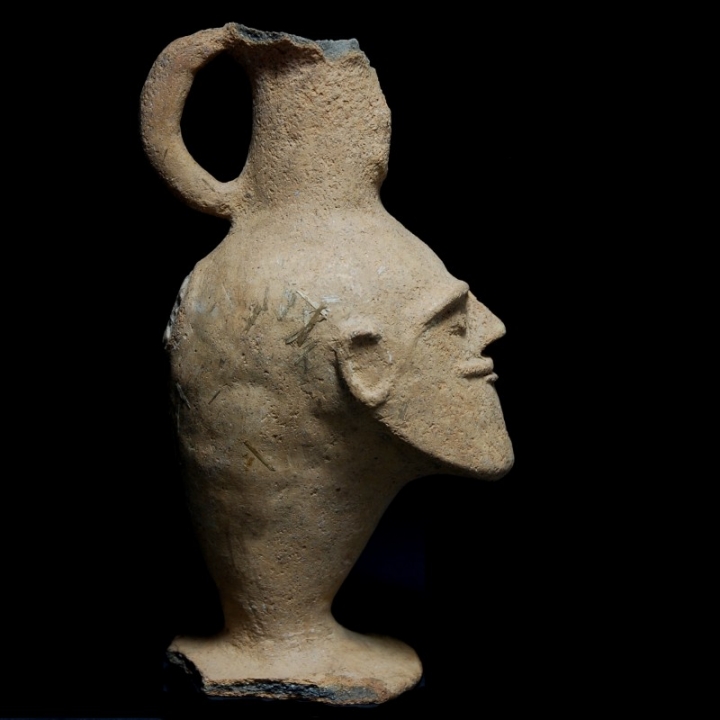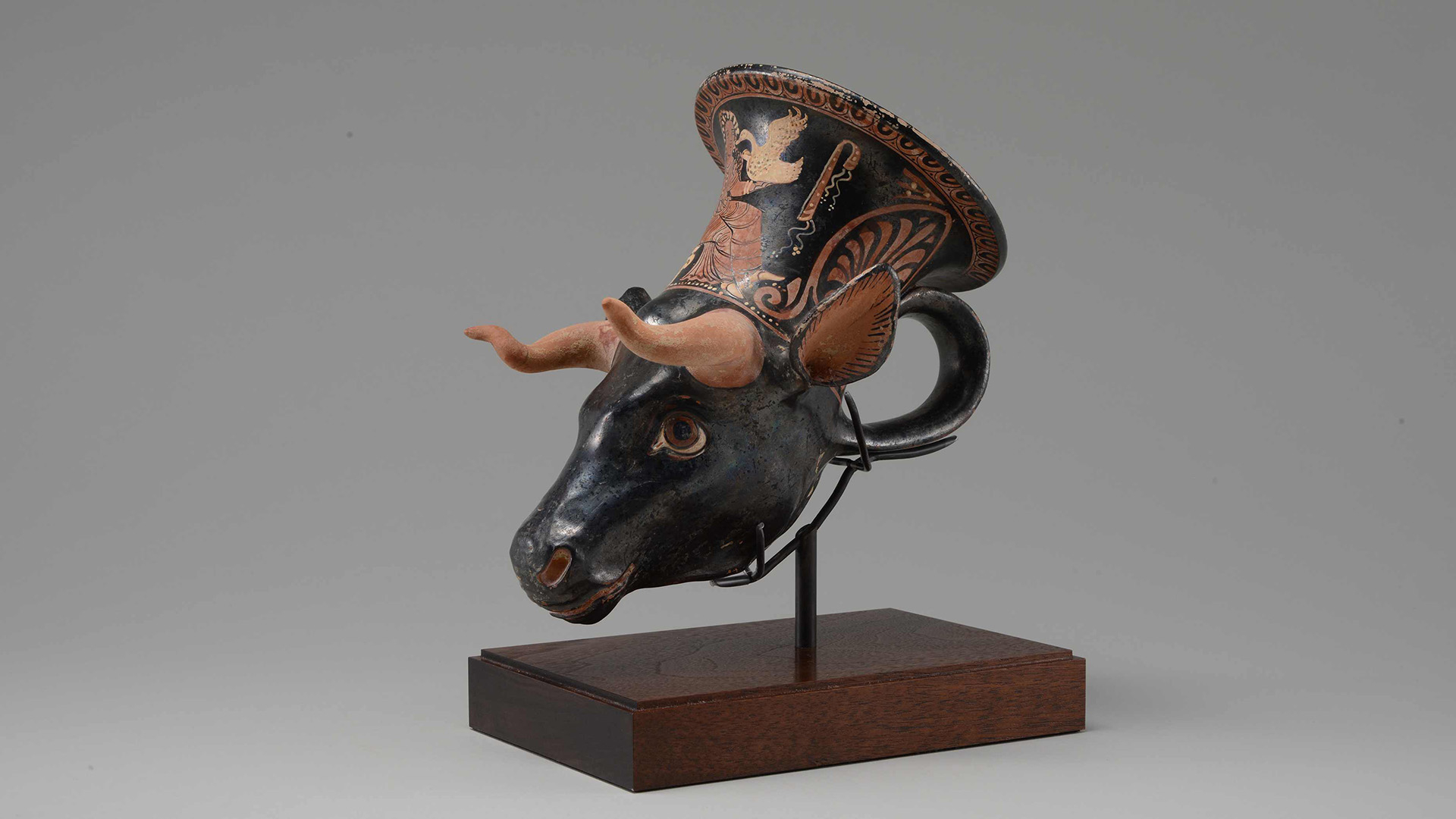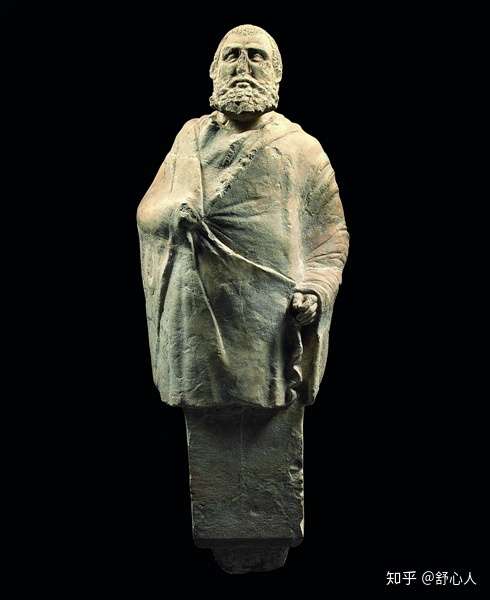Greeks and their arts in Asia
52 Silver gilt phaleron with a stretched griffin, from Novouzensk. (St Petersburg, Hermitage Museum)
54 Silver gilt medallion from south Russia, with a bust of Artemis. (St Petersburg, Hermitage Museum)
55 Silver gilt phaleron from Volodarka Kurgan, Kazakhstan. Bellerophon on Pegasus rides down the Chimaera. (After Mordvintseva)
56 Silver gilt phaleron from the Kuban. Dionysos rides a lion, and Athena fights a naked giant within a vine border. (After Mordvintseva)
59 Gold plaque from Tillya Tepe with Aphrodite and monsters. 1st cent. AD. (Drawing, author. After TTG)
60 The woman from burial 6 at Tillya Tepe. For the ornaments at ears and neck, see PLS. XXXII and XXXI. (After TT)
61 Inlaid gold roundel from a belt. A goddess (eastern maenad?) seated on a lion and holding a cup. 1st cent. AD. (Drawing, author. After TTG)
62 Inlaid gold plaque with a Triton holding an oar and a dolphin. 1st cent. AD. (Drawing, author. After TTG)
65 Gilt bronze cup from Datong (Shanxi, China) with a Vintage scene. 1st/2nd cent. AD (?). (After Rawson)[Carter 1995, pp. 262-263, n. 22]
63 Design of a man holding a dolphin from a Kushan silver coin. 1st cent. AD. (Drawing, author. After TTG)
64 Ketos and dragon heads. Left – Chinese; right – Greek; below – Tillya Tepe. (Drawing, author. After After Alexander)
65 Gilt bronze cup from Datong (Shanxi, China) with a Vintage scene. 1st/2nd cent. AD (?). (After Rawson)[Carter 1995, pp. 262-263, n. 22]
China: Dawn of a Golden Age, https://www.ajaonline.org/online-review-museum/378
The most striking objects of this section are a group of bronze and silver vessels (nos. 58–64), all unearthed in Datong, northeast of which was Pingcheng, the capital of the Northern Wei until 493. The floral patterns, the general shape, and motifs of the three stem cups (nos. 58–60; fig. 4) suggest their indebtedness to Hellenistic and Roman traditions.
SEE ALSO https://www.jstor.org/stable/24048829?read-now=1&seq=10#page_scan_tab_contents
SEE ALSO my book, 10_24 & _25
66 Gilt silver plate from Jingyuan (Gansu, China), featuring Dionysos on a leopard within a vineyard border. 1st/2nd cent. AD. (After China Digest)
67 Bronze kneeling warrior from a burial north of the Tienshan range. (Urumchi Museum. After DCAA. H. 42 cm)
XIV Gilt silver cup with maenads, one naked playing a syrinx, another dressed, with a torch. 3rd/2nd cent. BC. (Miho Museum, Shigaraki. H. 13.2 cm)
Kotyle with Mythical Figures, http://www.miho.or.jp/booth/html/artcon/00003374e.htm
XVII Gilt silver disc from Aï Khanoum, showing the goddess Cybele in a chariot, with priests, a radiate bust of a god, the moon and sun. 3rd cent. BC. (After Afghanistan. Diam. 24 cm)
XVIII Bronze statuette of a piping satyr, dedicated at Takht-I Sangin by one Atrosokes. 3rd cent. BC. (After Oxus. H. 33 cm)
XIX Ivory scabbard from Takht-I Sangin with a lion holding a deer, and on the chape a curled-up goat in nomad style. 4th cent. BC. (After Oxus. L. 27.7 cm)
XX Ivory forepart of a rhyton vase in the form of a lion, from Takht-I Sangin. 4th/3rd cent. BC. (After Oxus. H. 8.6 cm)
XXI Ivory head of Herakles wearing a lionskin cap, the pelt over his shoulders, from Takht-I Sangin. 3rd cent. BC. (After Oxus. Height 3.6 cm)
XXII Ivory relief from a scabbard with a winged female horse-fish, holding an oar and fruit, from Takht-I Sangin. 3rd cent. BC. (After Oxus. Width 11.8 cm)
XXIII Gold belt plaque showing a lion and boar fighting, in an unusual and possibly western style. From Xigoupan, north China. 5th/4th cent. BC (?) (After Boardman. 13 × 10 cm)
XXIX Gold belt buckle from Tajikistan. A Chinese horseman rides down a boar. The border is a classical ovolo. (After Treasures. W. 5.2 cm)
XXX Bronze rhyton in the form of a centaur holding a goat, from near Gilgit, Pakistan. 3rd/2nd century BC. (Oxford, Ashmolean Museum 1963.28. H. 27.5 cm)
Boardman, J. The Greeks in Asia
Graeco-Bactrian Vessel, ca. 3rd century B.C. (MMA, ac. nr:1992.232.3)
https://www.metmuseum.org/art/collection/search/327474
Bactrian Head Vase (2nd c. B.C.)
Description: Terracotta vase in form of a male head originating from the Indo-Greek kingdom of Bactria. The vessel stands on a broad base with a conical foot. Above it the plastically worked out head of a bearded man. The eyebrows are bulging, the mouth broad and smiling, the nose long and pointy. Followed by the cylindrical vase neck. On the front of the neck and the back of the head the imprint of a seal with the depiction of a king (most probably Menandros I).
https://www.cb-gallery.com/en/produkt/baktrische-kopfvase/
The Rabatak inscription is an inscription written on a rock in the Bactrian language and the Greek script, which was found in 1993 at the site of Rabatak, near Surkh Kotal in Afghanistan. The inscription relates to the rule of the Kushan emperor Kanishka, and gives remarkable clues on the genealogy of the Kushan dynasty.Pillar capital from Surkh Kotal, with central Buddha figure
Buddha (Indo-Greek art, National Museum of Delhi)
Οι λέξεις είναι γραφτό να απομνημονεύονται. Δεν πρέπει να λέγονται.
Βουδιστική στήλη του 4 ου αιώνα. Μουσείο Dunhuang.
https://www.facebook.com/photo.php?fbid=1211426525916814&set=a.114880948904716&type=3&theater
Head Image: Bovine head shaped wine pot with red and color, which from southern Italy, 4th century. /National Museum Photo
https://newsvideo.su/video/9748703
The famous Indian couple are trying their new Greek outfit with pleasure. Carved grey schist. Gandhara. Circa 3/4 century. Reputedly from Takht-I bahi in Mardan, Khyber-Pakhtunkhwa, Pakistan.
Double vision?! No! It’s a painted double headed pottery tomb guardian. Tang Dynasty. The most unusual design of the Ceramic sculpture of Tang Dynasty. Excavated from a Tang tomb which is located in Gong Yi city. Thus region was a very famous and prosperous ceramic production Center from 6th c. till 12 c.
https://www.britishmuseum.org/collection/object/G_1861-1127-13
Head from a bronze portrait statue of a North African; cast by the indirect lost-wax method, with incised beard, moustache and eyebrows. The lips, eyelids and eyelashes were made separately. The copper-plated lips were inserted from the inside, with the original red tint contrasting with the colour of the face. The lips are slightly parted and the teeth are of bone. The pupils of the eyes were originally of glass, and the whites of magnesium carbonate. The thick-walled casting of this bronze suggests a date of about 300 BC. The facial characteristics suggest that the man is North African, possibly an important member of the Berber peoples, the native Cyrenaicans.
Αυτή η παραστατική και ρεαλιστική ορειχάλκινη κεφαλή, χαρακτηριζόμενη έτσι με βάση και τις πέντε αισθήσεις παρόλην την ύπαρξη ιχνών εξιδανικεύσεως, θεωρείται ότι μάλλον απεικονίζει ντόπιο νεαρό ιππέα. Προέρχεται από τον Ναό του Απόλλωνος της Κυρήνης, πόλεως στην βορειοανατολική Λιβύη (Αφρική) χρονολογείται δε περί το 300 π.Χ. Για την χύτευση υιοθετήθηκε η έμμεση μέθοδος η λεγομένη 'της απώλειας κεριού', ενώ η γενειάδα και τα φρύδια χαράκτηκαν προσεκτικά μετά την χύτευση. Προκειμένου να επιτευχθεί ιδιαίτερη ζωντάνια τα χείλη κατασκευάστηκαν ξεχωριστά ακολούθησε δε ένθεση ερυθρού χαλκού. Η οδοντοστοιχία διαμορφώθηκε από οστά ζώων, οι κόρες έγιναν με ένθετη ύαλο, ενώ για το λευκό μέρος του οφθαλμού χρησιμοποιήθηκε αναθρακικό μαγνήσιο. Ακόμη και οι βλεφαρίδες κατασκευάστηκαν εκ των υστέρων και εν συνεχεία φυτεύτηκαν στην θέση τους.
Η Κυρήνη, θέση ανασκαφής του αγάλματος, ιδρύθηκε στην παράκτια αυτή θέση από τους Θηραίους το 630 π.Χ., υπό την αρχηγία του Βάττου Αριστοτέλους, πήρε δε το όνομα της από την πηγή Κύρη, που ήταν αφιερωμένη στον θεό Απόλλωνα. Η πόλη αναπτύχθηκε γρήγορα και εξελίχθηκε σε κέντρο του Ελληνικού πολιτισμού στην Βόρεια Αφρική, ενώ απετέλεσε επίσης μείζον εμπορικό κέντρο. Τον τρίτο αιώνα π.Χ., στην πόλη ιδρύθηκε η φιλοσοφική Σχολή της Κυρήνης από τον Αρίστιππο, μαθητή του Σωκράτους. Η πολυσύχναστη επιχειρηματική πόλη, κατέστη πολιτιστικός και ακαδημαϊκός κόμβος, ενώ ήταν γνωστή σε όλο τον κλασικό ελληνικό κόσμο ως η Αθήνα της Αφρικής. Η πόλη έγινε κτήση της Ρωμαϊκής Αυτοκρατορίας το 74 π.Χ., καταστράφηκε δε ολοσχερώς από σεισμό το 365 μ.Χ.
Το 300 π.Χ., η περίοδος που στην Κίνα ονομάζεται ως αυτή 'της Ανοίξεως και του Φθινοπώρου', ήταν επίσης η αρχή της Ελληνιστικής περιόδου εν συνεχεία των κατακτήσεων του Μ. Αλεξάνδρου. Αυτή η χάλκινη προτομή δείχνει τις εξαιρετικές τεχνικές χυτεύσεως και τις υιοθετηθείσες τεχνικές συνθέσεως, είναι επομένως σημαντική ως στοιχείο αναφοράς και κατανοήσεως της αρχαίας τέχνης του χαλκού.
Πυγμάχος σε ανάπαυση (Ελληνιστικό δευτέρου αι. π.Χ., Museo Tradizionale Romano, Rome, inv. 1065)
https://www.facebook.com/photo.php?fbid=777933162599488&set=pob.100011484338363&type=3&theater
https://www.facebook.com/photo.php?fbid=777933162599488&set=pob.100011484338363&type=3&theater
Boy from Ai Khanoum
πρώτος αι. μ.Χ., ανασκαφές Butkara I, Swat Museum (Pakistan, Gandhara Art)
Michael
Standing Aphrodite schist (from Dharmarajika, Taxila 1 st. c.) and Hellenistic (2nd c. BC, marble, MET acc. nr. 2006.509)
https://silkroad-museum-collection.jp/rhyton%ef%bc%88red-painted-ox-head-shaped-rhyton%ef%bc%89/
Ερυθρό ρυτό σχήματος κεφαλής βοοειδούς Ν. Ιταλία, τέταρτος αι. π.Χ., Height 20 cm, Collection number 104533
don't need such, it is written in thw Hikayama cataloge, coming from the Greek colony of Pugla ..This is Απουλία - Puglia .. colonized by Mycenaeans, even today some of them speek Grekanica - Greek like language.
Περιδέραιο με υάλινες χάνδρες διαθέτουσες χρωματικές δίνες (Μυκήνες, 14/13 αι. π.Χ)
Hikayama Ikuo Silk Road Museum
https://silkroad-museum-collection.jp/a-necklace-of-glass-beads-with-vortex-patterns/
Ορειχάλκινη υδρία με λαβή, Ελληνο - Ινδική, δεύτερος αι. π.Χ., Aphganistan
https://silkroad-museum-collection.jp/the-water-pot-with-a-handle/
Άτλας (Gandhara, Kushan period, 2-3 c. AD)
https://silkroad-museum-collection.jp/statue-of-atlas/
Έρωτες στεφανηφόροι, τρίτος / τέταρτος αι. μ.Χ. (Foundation Collection of the Dutch Museum of World Cultures, inv. no. TM 3954-2)
Hariti and Panchika, Gandhara, ca. first to third centuries AD. Museum of Asian Art, Berlin, inv. no. I.1184 (https://www.ancientworldmagazine.com/articles/graeco-buddhist-art-gandhara-connection/).
Another interesting example of the adaptation of Graeco-Roman iconography in Gandharan art is illustrated below. The phyllite sculptural group shows a seated man and woman, who at first sight might be confused with Bacchus Dionysus and Agathe Tyche.
In his right hand, the man holds a staff adorned with a pine cone (called a thyrsus), which was known in Graeco-Roman antiquity as the attribute of the god of wine. For her part, the woman holds a horn of plenty (cornucopia) in her right arm, which was the attribute of the goddess of prosperity. (Agathē Tychē literally means “excellent fate”.) The Kushan pair, however, does not depict Dionysus and Agathe Tyche, but Hariti and Panchika in richly draped dress of Hellenistic-Parthian fashion. As parental pair they offered a beloved theme in Graeco-Buddhist art. She was worshipped as the guardian deity of pregnancy, childhood and child rearing. Her spouse was considered the commander of nature-spirits called yasha (which may be compared to the nymphs and satyrs of Greek mythology, who are regularly encountered in the retinue of Dionysus).
According to Buddhist tradition Hariti bore Panchika five hundred children! This statuette thus further evinces the endurance of Hellenistic influences in the East as well as the local adoption of the international style.
Θραύσμα κεραμεικού από την Khotan (3/4 αι. μ.Χ., Hermitage Museum)
https://www.facebook.com/photo.php?fbid=717517858641019&set=pcb.717518465307625&type=3&theater
Σημειώσατε την χρήση επικολλούμενης μετωπικής διακοσμητικής κεφαλής κατά την αρχαιο - ελληνική παράδοση (ΚΙΝΕΖΙΚΟΣ 2_38)
Art Journey to the West 2017- Κεραμεικό θραύσμα δεικνύον τον Βούδα με περιδέραιο, παραβαλλόμενο με αντίστοιχα σελίθινα γλυπτά της Γανδαρίτιδας
https://www.facebook.com/photo.php?fbid=575699812822825&set=a.114880948904716&type=3&theater
Λίθινο ανάγλυφο δισκοειδές πινάκιο απεικονίζον την Αρπαγή της Ευρώπης (2ος αι. π.Χ. έως 1ος αι. μ.Χ.) (Gandhara, μάρμαρο, 9.5 εκ., Έκθεση "Από τη Μεσόγειο στην Κίνα" Έκθεση Συλλογής Μουσείων Τέχνης Hirayama Ikuo Silk Road)
Λίθινο άγαλμα καθήμενου Buddha με 'φλεγόμενους' ώμους (2ος έως 3ος αι. μ.Χ., περιοχή Jiabishi), έχει ήσυχο πρόσωπο, μισόκλειστα μάτια και έκφραση διαλογισμού, κυματιστά μαλλιά και φλεγόμενες φλόγες στους ώμους. Πολλά αγάλματα του Βούδα στην περιοχή Kabisch προέρχονταν από τη Gandhara.Το άγαλμα του πρίγκιπα στο νόμισμα της δυναστείας Guishuang έχει επίσης σχέδιο φλόγας ώμου. Η "Ιστορία των Δυτικών Περιφερειών της Δυναστείας των Τανγκ" του Xuanzang καταγράφει τον θρύλο του Jiabi Shiguo: "Θέλω να προσευχηθώ για ευλογίες, δηλαδή να σηκώσει μια μεγάλη φλόγα καπνού και στους δύο ώμους." Αυτός ο τύπος σχεδιασμού ώμου φλόγας θεωρείται ότι έχει την ίδια παράδοση με το γουδοχέρι του vajra. Η δύναμη του κακού δράκου επηρέασε επίσης την κινεζική βουδιστική τέχνη. (ύψος 39,5 εκ., πλάτος 30 εκ., Έκθεση "Από τη Μεσόγειο στην Κίνα" Έκθεση Συλλογής Μουσείων Τέχνης Hirayama Ikuo Silk Road)
Φιάλη με μετωπική προσθήκη απεικονίζουσα τον Διόνυσο και την Αριάδνη (J. Paul Getty Museum 83.AM.389)
<https://www.getty.edu/art/collection/objects/10753/unknown-maker-bowl-with-a-medallion-depicting-dionysos-and-ariadne-east-greek-about-100-bc/>
Προμετωπίδιο ίππου Ελληνικού - Ελληνιστικού τύπου (J. Paul Getty Museum 81.AM.89)
<https://www.getty.edu/art/collection/objects/9725/unknown-maker-prometopidion-or-forehead-ornament-from-a-horse-trapping-of-greek-hellenistic-type-greek-2nd-century-bc/>
Ερμαϊκή στήλη από το Ai Khanoum
http://www.miho.or.jp/booth/html/artcon/00003372e.htm
Λεοντόμορφος γρύπας από την Μαύρη θάλασσα (θραύσμα ρυτού του πέμπτου / τετάρτου αι. π.Χ. (επιχρυσωμένος άργυρος)
http://www.miho.or.jp/booth/html/artcon/00003382e.htm
A Greek parcel gilt silver mirror. Hellenistic period, circa 2nd-1st century B.C.
http://www.alaintruong.com/archives/2012/08/03/24827878.html
Boardman, J. 2015. The Greeks in Asia, London.
van Oppen, B. 2018. "Graeco-Buddhist art. The Gandhara connection. The entanglement of Graeco-Roman and Indian Buddhist culture is well reflected in Gandharan art dating to the early centuries of our era," ANCIENT WORLD MAGAZINE, <https://www.ancientworldmagazine.com/articles/graeco-buddhist-art-gandhara-connection/> (13 September 2020).
Cunrui Xiong, V. 2005. Rev. of China: Dawn of a Golden Age, in AJA 109.1, pp. 1-10.
https://www.ajaonline.org/sites/default/files/AJAonline_China_Dawn_of_a_Golden_Age%282%29.pdf
https://www.jstor.org/stable/24048829
Carter, M. L. 1995. “A Note on Metalwork from the Hellenistic East,” Bulletin of the Asia Institute 9 (New Series), pp. 257-266.

























































Δεν υπάρχουν σχόλια:
Δημοσίευση σχολίου